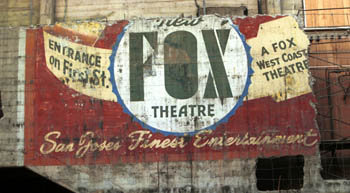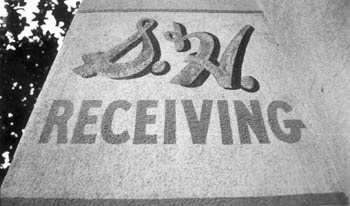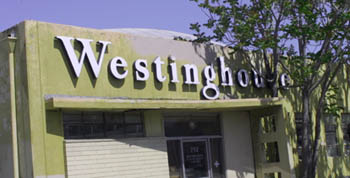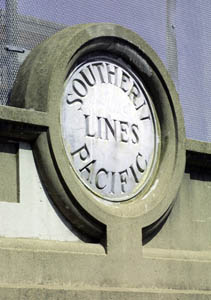![[Metroactive Features]](http://metroactive.com/features/gifs/feat468.gif)
[ Features Index | San Jose | Metroactive Central | Archives ]
Sign Language
What they say about our lives, and why action is needed to save the valley's scarce reminders of its commercial past
By Dan Pulcrano
A VALLEY THAT'S BEEN LOOTED of its orchards and historical structures is now also being progressively stripped of the text that contributes narrative to our lives. Funky expressions from a century of authentic evolution have yielded to the visual spam of the information age: safe, trendy, faux nostalgia, repetitive corporate branding, stucco monument signs, computer-generated vinyl appliques and backlit PVC.
The chronic battering of our surviving shreds of local soul attracts scarcely more than sporadic rubbernecking. Longtime icons are spirited off to salvage yards or private collections without fuss or ceremony,
Letters that have resisted the elements and economic cycles, meticulously fashioned of bent glass tubing or with a steady brush, are captions to our landscape, reference points in our journeys, time markers in our brief lives. Yet they are casually tossed aside by careless developers and contractors, who proceed unmolested by city officials asleep at the switch.
While a handful of cities on the West Coast and elsewhere have begun conserving these outdoor museums of commercial history, Silicon Valley has allowed its public spaces to be sanitized of any sense of roots and permanence, obliterating evidence of the days when owners operated businesses and made them their life's work. When we remove the context and chronology from our physical environment, we are diminished. If we track our days by quarterly announcements or the 18 months preceding an initial public offering, we participate in an unnatural illusion. Our actions become isolated events, soon to be forgotten, rather than essential links in a chain of history. The future will no doubt do to us what we have done to our past.
The velocity of the carnage has rendered me an old-timer prematurely. I've lived here since the 1980s and can remember well when the "Oh Boy! Keystone Coffee" sign blinked beside the Market Street overpass near Coleman and Julian, when an S&H Green Stamps logo adorned the loading dock behind the Reel Grobman architectural office at Second and St. John and when a large globe graced the top of the since demolished Heald Business College building at Santa Clara Street and Almaden, once home to the Mercury Herald. It stood right next to the De Anza Hotel, where a botched effort to save the diving lady sign in 1990 decontextualized the bathing-suit-clad damsel by crudely painting out the sign around her, leaving the leaper plunging headfirst toward the sidewalk against a smooth backdrop of Mediterranean earth-toned puree.
Another unforgivable sin was committed in the early '90s after METRO moved out of its original headquarters at 410 S. First St. in downtown San Jose. Workers replacing the lobby wallboard exposed an original Charlie Chaplin poster that had been glued to the brick to promote a screening at the theater next door. Instead of preserving it under glass in its place, an unsuccessful attempt to remove the collectible resulted in its destruction.
When the historic Costa Hall at 15 S. Third St. was torn down in 1995 to make way for a supermarket parking lot, the demolition exposed a faded painted sign for one of the block's former commercial tenants. Though the charming sign graced the still standing building occupied by Hank Coca Furniture, its reappearance in the light of day was short-lived. City-hired workers sandblasted off any trace of the antique.
The historical larceny happens so fast that vigilance taxes the memory. Maybe we should post observers, like the American Indians do at excavations that threaten ancient burial grounds. Whatever happened to that great old Metropole sign, I wondered, when scaffolding covered the old brick building during its renovation for tenant KnightRidder.com? Our reporter peered behind the construction netting and found that, sure enough, the nameplate had disappeared. Some investigation revealed that the sign wound up in the collection of contractor and history buff James Salata. Give it back, Jim.
While it's great to pay tribute to the past in museums, libraries and private collections, the reduction of living history to curios and collectibles is a municipal tragedy. How often do we visit Kelley Park or the California Room of the Martin Luther King Library? The Disneylandization of legacy and conversion of patrimony into bar wall decorations robs us all of the thought-inspiring daily reminders of seeing history in its proper context. History in a box creates a disconnect: That's how things used to be, isn't that quaint? History in the streets informs us that we are part of a continuum, ancestors to the future we create, our lives anchored by a present securely bolted to the slab of the past.
I am not sure why I feel good when I pass under the cement railroad bridge on Julian Street behind the San Jose Arena (I mean, uh, Compaq Center) and notice the Southern Pacific Lines seal, or see the old serif logo on the one-story Westinghouse Electric Supply Company building on the corner beside that underpass. It's somehow comforting to remember the days of railcars and vacuum tubes and fruit canning, when downtown buildings held people and not Internet servers, and cell phones didn't ring in restaurants. I suspect that others share those pleasurable moments when a streetside relic transports them for a few seconds. They are our time machines, and the ride is free.
But keep your eyes open, because if you blink, you'll miss it.
His photographs, along with Genevieve Roja's exhaustive effort to catalogue and document some of the remaining gems of the valley's agro-industrial era, attempt to focus attention on the declining inventory of historically significant commercial signage that exists locally. Hopefully, community leaders and preservationists can halt further damage to the South Bay's public streetscapes.
It is a matter of more than selfish interest for the valley's charm-starved quality-of life-advocates. Historians, students, foreign visitors and business writers regularly comb our city streets looking for clues to the genesis of the miracle that is Silicon Valley. We really ought to give them more than a few photographs to look at.
Old Signs: Silicon Valley's Disappearing Legacy
Plaque Removal: Metro reporter Genevieve Roja takes a neon-lit journey in search of the valley's oldest and most intriguing signs.
Hand-Painted Wonders: Long before graffiti, brick buildings were a palette for sign painters. Today, they are endangered species.
Strokes of Genius: An interview with octogenarian sign-painter Rey Giese.
Telltale Signs: Close-up looks at the Courtesy Chevrolet and Orchard Supply Hardware landmark signs.
Pooch Politics: Famed cartoonist takes doggie-head sign to heart.
Living Large: Giant roadside statues are often 'borrowed.'
Signs From the Underbelly: Columnist Eric Carlson offers a photographic tour of some of the most interesting signs in San Jose.
[ San Jose | Metroactive Central | Archives ]
Copyright © 2001 Metro Publishing Inc. Metroactive is affiliated with the Boulevards Network.
For more information about the San Jose/Silicon Valley area, visit sanjose.com.
![]()

Photograph by George Sakkestad


 A few months back, when demolition of the Hyatt Sainte Claire's parking structure exposed a sign on the Fox Theatre's back wall, I put in an urgent call to METRO photographer George Sakkestad, asking him to snap a shot. By the next day the wrecking ball had smashed through the concrete wall--that's the way things go in this town. Thanks to George's quick action, the image is captured at the top of this page.
A few months back, when demolition of the Hyatt Sainte Claire's parking structure exposed a sign on the Fox Theatre's back wall, I put in an urgent call to METRO photographer George Sakkestad, asking him to snap a shot. By the next day the wrecking ball had smashed through the concrete wall--that's the way things go in this town. Thanks to George's quick action, the image is captured at the top of this page.
From the April 26-May 2, 2001 issue of Metro, Silicon Valley's Weekly Newspaper.